This was published 7 years ago
The ultimate food-lover's guide to Italy's best restaurants
By Janne Apelgren and Joanna Savill
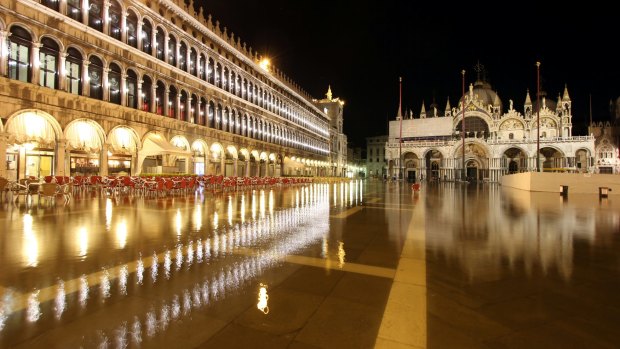
Restaurant Quadri, Italy.Credit: Sergio Coimbra
The great Italian boot, across its cities, towns and villages, is brimful of fabulous places to eat and drink. While its favoured food-travel destinations are riddled with tourist traps – and in Italy, they do abound – homey trattorie serving rustic specialties will see you right most of the time.
Regional pasta specialties (not Anglo inventions) are always a fail-safe option. And forget "spaghetti bolognaise" – true bolognese is a slow-simmered meat ragu served with tagliatelle, a wide ribbon pasta. And it's well worth leaving the well-worn path to escape the crowds.
So we've taken an eclectic route, to share favourites, classics and some spectacular spots – chosen for their views, stories, people and, of course, their food. But we start, as many travellers will, and probably should, in the Eternal City, Rome.
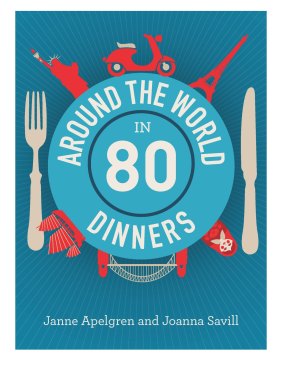
Around the World in 80 Dinners by Janne Apelgren and Joanna Savill.
ROME
THE LOWDOWN
The city offers antipasti, pasta, pizza, gelato – some of the planet's best-loved foods. So why are diners often disappointed by their Roman holiday? Local expert Katie Parla says it's because places tend to do one or two things really well, and you have to know what those specialties are. Rome's signature pasta dishes are simple: spaghetti cacio e pepe – cheese, black pepper and pecorino romano (sharp, aged sheep's cheese) – and spaghetti carbonara – egg, pancetta, lots of pepper, never cream – a golden Roman staple.
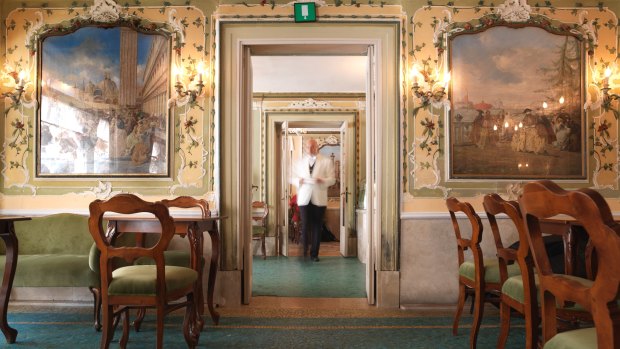
Inside Quadri, Venice.Credit: studio04
WHERE TO EAT
L'Arcangelo
The potato gnocchi at L'Arcangelo have been named among Italy's best. It's a long time since we've walked into a restaurant playing Georgie Girl and She's Having My Baby, and one might be tempted to judge a place by its 1960s and '70s soundtrack. But at this landmark local in the Prati neighbourhood, where we're the only diners speaking English, it somehow feels right, comfortable amid the faded sepia photographs, memorabilia, brick floors, red banquettes and timber-panelled walls.
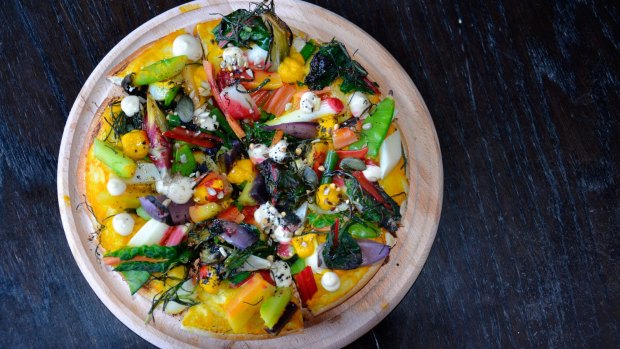
Pizza, Restaurant Quadri, Venice.Credit: Sergio Coimbra
Traditional Roman food is the reason for coming to chef Arcangelo Dandini's restaurant, especially for those gnocchi, most famously served alla matriciana, with fresh tomato sauce, cured pork cheek (guanciale) and pecorino romano cheese.
Most diners warm up on crisp crumb-crusted suppli, golden croquettes of rice with gluey cheese hearts. They're just a support act. The gnocchi manage to eclipse them: light, soft and pillowy. The night of our visit they come luxe with French butter and aged pecorino and makes you realise how rare proper, perfect gnocchi are.
We try the chef's celebrated matriciana: al dente rigatoni, flecked with gamey guanciale. And forget spaghetti alla carbonara (another Roman dish, the black pepper supposedly paying homage to the coal-blackened faces of the miners who favoured it). Here it's done with short, tubular pennoni instead. Offal and game are very Roman, too, so when in Rome try the tripe, or pigeon. There's also some less traditional culinary trickery: a white chocolate dessert "soup" features extra virgin olive oil and candied ginger. That may put culinary sceptics on red alert, but it's an interesting signature. Book online easily, in English. See larcangelo.com
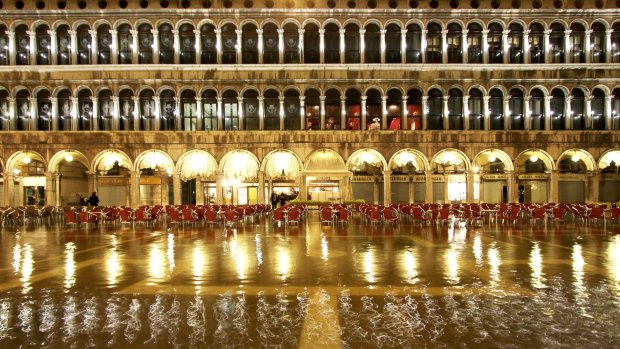
Restaurant Quadri in St Mark's Square, Venice.Credit: Sergio Coimbra
INSIDER TIP
Dandini also has Supplizio (larcangelo.com), a casual street-food spot, in the city's historical heart. If L'Arcangelo is an institution, Roscioli (salumeriaroscioli.com) is legendary. Family run, it's renowned for its wine list, burrata (fresh milky cheese balls with a creamy liquid centre), salumi and pasta, eat-in or takeaway. Local experts advise sitting upstairs, near the back, and popping in for aperitivi after 6pm if you can't snag a table booking.
ONE MORE THING…
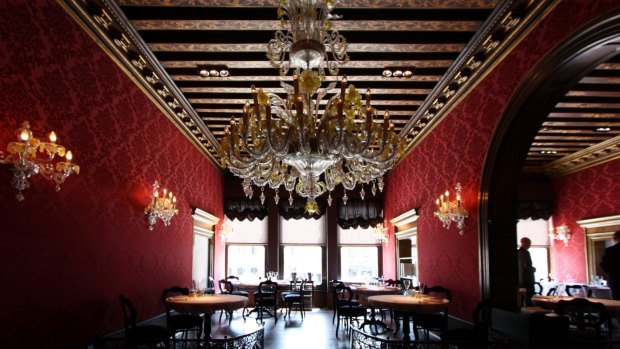
Inside Quadri, Venice.Credit: Sergio Coimbra
Emma Pizzeria (emmapizzeria.com) is a tricky-to-find, casual spot with some of Rome's best pizza. The pizze are more expensive than many you'll find in Rome but they draw on the skills of baker Pierluigi Roscioli and plundering Roscioli deli's best ingredients as toppings. They're thin crusted – the Roman way – and charry edged, beneath ribbons of Parma prosciutto and blobs of buffalo mozzarella, or wild fennel and rocket, and use quality organic flour, salt and olive oil.
VENICE
THE LOWDOWN
Venice exudes its own magic, whatever the season, no matter how dense the crowds. And resistance is futile – once you've thrown yourself into the school of human traffic that flows along Venice's pedestrian streets, you're almost certain to be swept up in a tide that deposits you at the magnificent Piazza San Marco (St Mark's Square). Here, in the so-called "drawing room of Europe", surrounded by a millennium's worth of architectural genius, settling at a table outside one of the old coffee houses is irresistible.
WHERE TO EAT
Quadri
In a palazzo right on this most famous of squares, with a beautiful suite of relaxed downstairs dining rooms and a Michelin-starred restaurant upstairs, Quadri traces its lineage back to 1638. Climb stairs beyond the more casual and inexpensive lunch-until-late abcQuadri to the formal restaurant, where the leather-aproned sommelier pours a glass of gently bubbling franciacorta, northern Italy's classically made sparkling wine, then swirls a buttery chardonnay in a huge glass designed especially for the restaurant.
The Alajmo family, fifth-generation chefs and restaurateurs, now runs this historic cafe and restaurant, a seductive destination diner. Massimiliano (Max) Alajmo was said to be the youngest chef to receive three Michelin stars when, at 28, his Padua restaurant Le Calandre reached those heights back in 2003. It's stayed there ever since – and is well worth visiting if you're heading that way.
Quadri is billed as the square's only fine-dining restaurant, and with window tables overlooking St Mark's Square, it is, unsurprisingly, a favourite spot for marriage proposals. The maitre'd reveals there's a young man waiting below for a table to surprise his girlfriend. At 9.30pm two diners leave, the table is reset pronto, and the young man gets the call. Within minutes his proposal is made, and champagne uncorked. Seems she said yes.
It's a lovely paradox that almost every detail of this 1775 restaurant is protected and photography and mobile phones are banned, but that the wine list comes on an iPad. From our lower-level table in the red flock-papered and timber-panelled room, the view is of the upper storey of the square, and the room's ancient painted beams, velvet chairs and double-clothed tables. A Venetian-inspired menu draws on the fruits of the lagoon – tiny sea snails, baby clams, tendrils of cuttlefish with burrata ravioli. Bookings can be made easily online on the restaurant's website. See alajmo.it
INSIDER'S TIP
Quadri's downstairs options, abcQuadri and Gran Caffe Quadri, are both less formal and less pricey.
ONE MORE THING…
Behind Palazzo Barbarigo, at Da Ignazio (trattoriadaignazio.com) don't be surprised to see a waiter or a cook in their 80s. This family-run neighbourhood charmer is now in its seventh decade. An inviting front room conceals a tempting pergola-covered garden dining area. Lovingly made Venetian classics at reasonable prices.
THE DOLOMITES
THE LOWDOWN
Two hours north of Venice, Italy feels very different. Bilingual signs are the product of this region's past as part of Austria and it is still known as the South Tyrol. Towns have names in both Italian and German. Menus are dotted with dumplings, strudel and smoky speck, and the local wines show Austrian and German influences.
WHERE TO EAT
Gostner Schwaige
It's near the small town of Compaccio in the Alpe di Siusi that Franz Mulser runs a tiny restaurant, Gostner Schwaige, in a mountain dairy hut on land his family has farmed for 600 years (schwaige is the dialect name for "dairy hut").
In 2000, Mulser left behind a career at top restaurants in Germany, Austria and Spain to come home to the Dolomites, hoping to keep the family farm financially viable by starting a restaurant using its produce. Now plots overflow with herbs and edible flowers including nasturtiums, borage and fennel. Their herd's milk is transformed into five types of cheese, and the farm's veal, beef and lamb feature on the menu. It's a rural idyll made more charming by its remoteness.
The dining room takes only 15 or 20 for dinner, at six plain timber tables adorned with candles and jars of wildflowers; outdoor tables seat more for lunch.
The tall, young chef looks completely relaxed in traditional lederhosen, felt hat and vest, stooping slightly below his restaurant's beamed ceilings to deliver food that's simple yet sophisticated. There's pine pesto on ravioli, and beef, full-flavoured from grazing the alpine grasses and herbs. As we step out into the crisp summer air, we're already planning to come back, perhaps by horse and sled. "It's very romantic in winter," says Mulser, "with a full moon on the snow". There's no website. For bookings email gostnerschwaige@rolmail.net or call +39 347 8368154
INSIDER'S TIP
In winter, the menu's star attraction is soup (zuppa di fieno) in a bowl of bread baked by Mulser, on a nest of the farm's hay, flavoured by 25 different herbs and flowers gathered from the surrounding meadow.
ONE MORE THING…
Be warned: Gostner Schwaige is not easy to find. For starters, it's hidden in an alpine glade at an altitude of 1930 metres that you can only reach on foot, skis or by horse. In summer, you hike there across chocolate-box beautiful meadows surrounded by jagged peaks, calling cuckoos, chiming cowbells, and babbling brooks. In winter, skiers pick their way home from dinner by torchlight.
LOMBARDY
THE LOWDOWN
Italy is a crowded place. And sometimes it pays to explore parts less known. Take the northern region of Lombardy, for example. It's easily reached from its capital, Milan and it has some of Italy's most diverse scenery – from mountains to lakes, and large cities to the sprawling but fertile Po Valley. The plains around the Po are home to pretty towns such as Cremona and Mantua, where one of Italy's most famous restaurants, Dal Pescatore (see below) is located.
WHERE TO EAT
Dal pescatore
One of Italy's most famous restaurants was once a humble river fisherman's residence. The fisherman was Alberto Santini's great-grandfather. With his gracious father, Antonio, he now oversees the restaurant's generously spaced ochre and yellow dining rooms, greets you at the dining room entrance and curates the hefty leather-bound wine list, in which bottles from all over the world are classed by style then year. "The year is the key," Alberto explains. "That's how you understand everything."
In the kitchen, among polished copper pots, is nonna Bruna, still active in her late eighties. Bent over the stoves is Alberto's brother Giovanni and, smiling warmly, his mother, Nadia, head chef alongside her son. There's a cosy waft of roasting, broth simmering and the tickle of parmesan: the smells of an Italian country kitchen.
The Santinis may possess three Michelin stars and countless awards (Nadia was named Best Female Chef in the world, in 2013) but they're all about their terreno, the lesser known region of lower Lombardy, bordering on Parma and Emilia-Romagna.
And so from the enormous, decorated menu (the cover changes seasonally), we choose the simple foods of the area: tiny snails topped with garlicky crumbs, little agnoli (ring-shaped pasta parcels) in clear chicken broth, grilled eel – clean, white flesh on rich, gently fatty skin and, naturally, tortelli. Bulging around a rich, jammy, pumpkin and amaretti-crumb filling, they're rectangular bonbons of finely rolled egg-yellow pasta.
Around us, mostly couples dine in careful, elegant silence as a fire crackles in the huge chimney. Solemn waiters bearing oversized trays march briskly between tables. Antonio circulates, gently inquiring and nodding. Alberto carefully decants a premium barolo. It's seamless, effortless, old school but timeless, right down to the thick, fluffy zabaglione in a miniature copper pot that arrives with a delicate pistachio mousse topped with tiny meringues. Book via an email form on the website. A month's notice is advisable and a credit card deposit required. See dalpescatore.com
INSIDER TIP
In summer, ask for a garden table. The restaurant is closed in the second half of August.
ONE MORE THING…
The Brescia area of Lombardy is well worth exploring. Aside from its ancient ruins, which date to 27BC when it was the first northern outpost of the Roman Empire, it's home to all of the things that make eating in Italy exciting: pasta, wine, aperitivi, cheeses, smallgoods, bakeries and gelato.
MODENA
THE LOWDOWN
South of Milan, the region of Emilia- Romagna is home to the wealthy princes of parmesan, prosciutto and balsamic vinegar – the tradition-bound artisans and powerful consortia behind some of Italy's best-known exports. The Emilian city of Modena is a jewel – narrow medieval streets, snappy designer shops and hidden galleries, its own leaning tower and, currently, the No. 1 restaurant on the 2016 World's 50 Best Restaurant list.
WHERE TO EAT
Osteria Francescana
Overnight success here has only taken 21 years. The exuberantly charismatic force of nature that is chef Massimo Bottura opened his original Modena "tavern" in 1995 to less than universal acclaim. This local boy's decision to rework the ingredients and dishes of his childhood caused widespread consternation in the early days of this modest seeming restaurant, housed behind a softly pink facade among the yellows and oranges of a narrow, cobble-stoned Modena street.
Beyond the discreetly plain brass plate outside, the entrance feels like a gallery foyer, thanks to Bottura and wife Lara Gilmore's eclectic collection of serious contemporary art. Waiters in dapper suits and ties usher us to a clothed table in one of two hushed, carpeted rooms (there are only 12 tables). Folding out the giant hand-painted menu, we gently tiptoe into Francescana World – the blend of memory, tradition, music, art and whimsy that finds its natural home here.
It's hard to know what to order. There's a trad a la carte structure – superb cured meats, antipasti, primo, secondo, cheese and dolce – playing on regional specialties and a few outside influences (lacquered duck with Asian spices, for example). There are the Bottura classics, on the "Tradition in Evolution" menu: "An Eel Swimming Up the Po River", "Five Ages of Parmigiano Reggiano", "The Crunchy Part of the Lasagna" and the cutely named dessert, "Oops, I Dropped the Lemon Tart". Each tells a story of the place and its history, the chef's childhood, Emilian magic.
For all the hype, in essence Osteria Francescana is simply about beautiful ingredients and the utmost care: in homage to Italy, Emilia and all that makes them great. Book up to three months ahead, but hop online fast when bookings open on the first of each month. Try the wait list, too. See osteriafrancescana.it
INSIDER TIP
While you're in Modena, have an aperitivo at Archer Modena wine bar (via Cesare Battisti, 54), and visit a nearby balsamic vinegar museum and a parmigiano reggiano "factory".
ONE MORE THING…
The seasonal "Sensations" menu – full of tripping summer lightness and colour – includes new inspirations, such as a brilliantly hued flower salad and a glorious tomatoey "pizza" of rice and polenta.
ALBA
THE LOWDOWN
The Barolo (or Langhe) region of Piedmont is so picture-postcard pretty. You know: rolling green hills topped with tiny ochre-walled towns, narrow lanes, leafy vines laid out in rows across waves of fields like neatly striped blankets.
You expect Cinderella or Rapunzel to appear at the castle gate any minute, or Puss-in-Boots to come striding down a cobbled alleyway. It's where you'll find Italy's most prized wine – barolo – and the hazelnuts and white truffles that make Piedmont so famous. Central to this great gastronomic tradition is the small town of Alba.
WHERE TO EAT
Piazza Duomo
The Ceretto family makes some excellent barolo (including several single-estate and organic wines) and also owns this exquisite restaurant, set on the first floor of a sturdy medieval square. A highly recognised, three Michelin star operation, Piazza Duomo is led by the delightfully self-deprecating chef Enrico Crippa. The space itself is surprising: a wide, open, light-filled upstairs room in a suitably ancient building, the interior painted in a softly intense pink overlaid with gloriously delicate murals by one of Italy's most famous contemporary artists, Francesco Clemente. A giant vine leaf and its winding tendrils stretch over the four walls, looping around images of sailing boats, maps of the world and more.
Then there's the excitement of the seasons and all that Langhe produce: cheeses, hazelnuts, grand wines and truffles. Crippa has his own properly functioning kitchen garden – five hectares – and draws on this, as well as regional tradition, to put together his bright, modern dishes, all as colourful and postcard-y fresh as the region itself. Menus are named accordingly: Escape and Territory, Tradition and Innovation, or simply Degustation.
The parade of snacks is extraordinary: sticks of fried spaghetti bristling from stone blocks, the pasta dipped in a carbonara-themed sauce, "olives" that aren't, stuffed with a tartare of prawn and another of game. We will never forget a simple dish of tiny whitebait, dotted over the plate.
And then there is the most zingy salad ever – a pile of leaves, flowers and herbs, served suspended over a glass bowl containing a dashi broth. As you eat, juices accumulate below, making up your final spoonfuls. It's known as Insalata (salad) 21, 31, 41, 51; the numeral refers to the number of ingredients included, depending on the season. We're given a list at the end. Ours contains the full 51 – everything from nori to red basil, calendula, borage, mizuna, shiso, wild rocket, ginger and violets. It's all about colour and the seasons, each plate a canvas in itself. Book online and at least three days out, much earlier during truffle season. See piazzaduomoalba.it
INSIDER'S TIP
There's also La Piola downstairs. It's not fine dining, just local and good. Crippa also oversees the kitchen.
ONE MORE THING…
Get here during the annual White Truffle Festival (October and November) and book in a tour of the Ceretto wineries (ceretto.com). Look out for their famous glass "Cube", another called "The Acino" (referring to its grape-like shape) and the little chapel on a lone hillside outside town painted in rainbow colours by artists David Tremlett and the great Sol LeWitt.
This is an edited extract from Around the World in 80 Dinners by Janne Apelgren and Joanna Savill (MUP, RRP $45, eBook $22.99).It's available from tomorrow, October 31, from mup.com.au and everywhere books are sold.
APERITIVO NATION:
FIVE MUST-TRY ITALIAN DRINKS
APEROL Made from bitter and sweet oranges, rhubarb and other ingredients, its flavour is intensely orange. It has an alcohol content of 11 per cent and is most commonly drunk before dinner as aperol spritz, mixed with prosecco and soda.
AVERNA Sicilian, made from herbs, and with an alcohol kick of 32 per cent, this 19th-century digestive can be used in cocktails, or drunk straight or on the rocks.
CAMPARI First concocted by a bar owner in Milan in the 1860s and made from fruit and herbs, this distinctively scarlet beverage can be drunk with soda or juice (ideally blood orange) or in cocktails including the Americano and negroni. Its alcohol content is around 25 per cent.
FERNET BRANCA Barfolk often describe the taste as "medicinal" (read: lip-puckering) yet this intense bitter concocted from 27 herbs, roots and flowers to a secret recipe devised by Bernadino Branca in 1845 has many hip devotees. Drink it straight (but beware, it's 39 per cent alcohol) or with chinotto (a soft drink made from tiny bitter citrus).
MONTENEGRO Dating from 1885, milder-flavoured, sweetish Montenegro can be drunk straight, hot, cold or in cocktails like the Montegrita.
FIVE PLACES TO STAY IN ITALY
PALAZZO BARBARIGO, VENICE
A palazzo-turned-hotel on a corner of the Grand Canal, has onyx-hued rooms with canal views, an inviting bar, great breakfasts and owners who personally deliver fabulous service. In a city of expensive hotels, it's neither the cheapest nor the priciest. See palazzobarbarigo.com
HOTEL GRONES, THE DOLOMITES
In the pretty town of St Ulrich/Ortisei, Hotel Grones is a family-run operation where the owner wears a dirndl to greet guests, and a chef wearing a toque delivers regional specialties at well-priced dinners. See grones.info
ALBERGO OROLOGIO, BRESCIA
Albergo Orologio is a cute, low-ceilinged three-star hotel in the historic centre of Brescia, a city in the Lombardy region of northern Italy. The hotel has a small living room with soft armchairs where you can sit and relax, read a book or surf the net. See albergoorologio.it
PIAZZA DUOMO, ALBA
This three-star Michelin-rated restaurant (see main story) boasts three smart, minimally designed and fully equipped rooms and a suite, dedicated to diners. The accommodation is conveniently located opposite Piazza Duomo. See piazzaduomoalba.it
STELLA 21, MODENA
Stella21, is a stylishly furnished contemporary bed and breakfast in an 18th-century building in the historic centre of Modena, just over the road from Osteria Francescanam (see main story). See stella21bedandbreakfast.it
ABOUT THE WRITERS
Janne Apelgren and Joanna Savill, co-authors of the new book, Around the World in 80 Dinners, have between them edited 14 editions of Fairfax Media's Good Food Guides in Victoria and NSW. They have spent their working lives travelling to eat and advising diners on the best places to eat both in Australia and oversea.
Sign up for the Traveller Deals newsletter
Get exclusive travel deals delivered straight to your inbox. Sign up now.